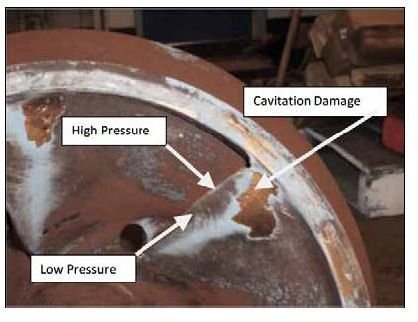Centrifugal Pump, Cavitation, Implosion, Net Positive Suction Head
Centrifugal Pumps – Operational Problems & Remedies
Introduction
Enough has been said about the Centrifugal Pumps and their principle of operation. However, during the operation of these pumps, several problems are faced which have to be looked into during their operation in order to get trouble free service from these pumps. The main problem, typical to centrifugal pumps, faced by these pumps is Cavitation, which is caused by the fact that these pumps operate with suction pressure much below the atmospheric pressure. This occurs mainly in the pumps used for transferring water. Other problems faced by these pumps are mainly due to normal wear and tear of the materials over a period of time.
What is Cavitation?
During the pump operation, as the water mass passes from eye of the impeller towards its periphery, it creates vacuum at the eye of the impeller and inside the suction pipe. If the temperature of the water passing through the suction pipe and the eye of the impeller happens to be higher than the saturation temperature of the water at the prevailing vacuum, some of the water may evaporate to form tiny vapor bubbles, which travel through the impeller. As the water mass passes from eye of the impeller towards its periphery, its pressure rises and the vapor in the tiny bubbles becomes unstable and condenses back to liquid causing small implosions in these bubbles. These implosions in the tiny vapor bubbles in the water mass have enough energy to cause pitting in the adjoining material of the impeller as well as the pump casing. This process of impeller and the casing material wastage is called Cavitation.
As the pump operates at a particular Available Net Positive Suction Head, the Cavitation is found to occur at a particular location on the pump impeller and its casing. The location may vary from pump to pump as different pumps operate at different Net Positive Suction Heads. After several years of use, the pitting causes the wastage in the impeller and the casing material sufficient to make it weak requiring replacement.
The only remedy to prevent Cavitation in any pump is to ensure that the temperature of the water passing through the suction pipe and the eye of the impeller is maintained below the saturation temperature at the prevailing vacuum. Apart from that, the inner surface of the casing may be coated with hard epoxy layer to minimize the effect of Cavitation.
Other problems related to the centrifugal pump operation are mainly due to wear and tear in the moving parts due to friction namely;
- Increase in the clearance between the impeller neck and the wear rings resulting in reduction in volumetric efficiency. Replacement of wear rings is the only remedy for this.
- Damage to the impeller shaft in the way of gland packing which may be rectified by replacement of the shaft or, if the shaft is fitted with a sleeve, by replacing sleeve.
- Wearing of / damage to the bearings leading to increased power by the pump. This may be rectified by replacement of the bearings.
